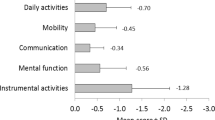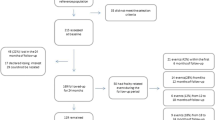Abstract
Background
Disability is commonly considered as an irreversible condition of advanced age. Therefore, preventive actions need to be taken before the disabling cascade is fully established, that is in the pre-disability phase defined “frailty syndrome”. The complexity and heterogeneity of frailty requires a clinical approach based on multidimensionality and multidisciplinary. In this paper, we present the main characteristics of the newborn Platform for Evaluation of Frailty and Prevention of Disability (Toulouse, France).
Intervention
Persons aged 65 years and older screened for frailty by general practitioners in the Toulouse area are invited to undergo a multidisciplinary evaluation at the Platform. Here, the individual is multidimensionality assessed in order to preventively detect potential risk factors for disability. At the end of the comprehensive evaluation, the team members propose the patient (in agreement with the general practitioner) a preventive intervention program specifically tailored to the his/her needs and resources.
Results
Mean age of our population is 82.7 years, with a large majority aged 75 years and older. Most patients are women (61.9%) Approximately two thirds of patients received any kind of regular help. Regarding level of frailty, 65 patients (41.4%) were pre-frail, and 83 (52.9%) frail. For what concerns the functional status, 83.9% of patients presented slow gait speed, 53.8% were sedentary, and 57.7% had poor muscle strength. Only 27.2% of patients had a SPPB score equal to or higher than 10. Autonomy in ADL was quite well preserved (mean ADL score 5.6 ± 0.8) as expected, suggesting that the patients of the platform have not yet developed disability. Consistently, I ADL showed a marginal loss of autonomy reporting a mean score of 6.0 ± 2.3. About one third of patients (33.1%) presented a MMSE score lower than 25. Dementia (measured by the CDR scale) was observed in 11.6% of the platform population, whereas subjects with mild cognitive impairment (that is CDR equal to 0.5) were 65.8%. New diagnosed depressive disorders were relatively rare with only 3.2% of patients showing signs of depression but some people were already treated. Numerous patients presented vision problems with 10.4% having abnormal findings at the Amsler grid. Finally, it is noteworthy that 9% of the platform population presented an objective state of protein-energy malnutrition, 34% an early alteration of nutritional status, while almost everyone (94.9%) had a vitamin D deficiency (partially explained by the period of the year, that is winter-spring, of most of the measurements).
Conclusion
The Platform clinically evaluates and intervenes on frailty for the first time at the general population-level. This model may serve as preliminary step towards a wider identification of early signs of the disabling cascade in order to develop more effective preventive interventions.
Similar content being viewed by others
References
Clarfield AM (1990) Dr. Ignatz Nascher and the birth of geriatrics. CMAJ 143(9):944–948.
Fried TR, Bradley EH, WiLiams CS, Tinetti ME (2001) Functional disability and health care expenditures for older persons. Arch Intern Med 161(21):2602–2607.
Fried LP, Tangen CM, Walston J, Newman AB, Hirsch C, Gottdiener J, et al (2011) Frailty in older adults: evidence for a phenotype. J Gerontol A Biol Sci Med Sci 56(3):M146–M156.
Rubenstein LZ, Josephson KR, Wieland GD, English PA, Sayre JA, Kane RL (1984) Effectiveness of a geriatric evaluation unit. A randomized clinical trial. N Engl J Med 311(26):1664–1667
Stuck AE, Siu AL, Wieland GD, Adams J, Rubenstein LZ (1993) Comprehensive geriatric assessment: a meta-analysis of controlled trials. Lancet 342(8878):1032–1036.
Monteserin R, Brotons C, Moral I, Altimir S, San José A, Santaeugenia S, et al (2010) Effectiveness of a geriatric intervention in primary care: a randomized clinical trial. Fam Pract 27(3):239–245.
Vellas B, Cestac P, Moley JE (2012) Editorial: implementing frailty into clinical practice: we cannot wait. J Nutr Health Aging 16(7):599–600
Rodríguez-Mañas L, Féait C, Mann G, Viña J, Chatterji S, Chodzko-Zajko W, et al. (2012) Searching for an Operational Definition of Frailty: A Delphi Method Based Consensus Statement. The Frailty Operative Definition-Consensus Conference Project. J Gerontol A Biol Sci Med Sci.
Cesari M (2012) Frailty and Aging. J Frailty Aging. 3–6.
De Vries NM, Staal JB, van Ravensberg CD, Hobbelen JSM, Olde Rikkert MGM, Nijhuis-van der Sanden MWG (2011) Outcome instruments to measure frailty: a systematic review. Ageing Res Rev 10(1): 104–114.
Pel-Littel RE, Schuurmans MJ, Emmelot-Vonk MH, Verhaar HJJ (2009) Frailty: defining and measuring of a concept. J Nutr Health Aging 13(4):390–394.
Cesari M (2011) The multidimentionality of frailty: many faces of one single dice. J Nutr Health Aging 15(8):663–664.
Abelian van Kan G, Rolland Y, Andrieu S, Bauer J, Beauchet O, Bonnefoy M, et al (2009) Gait speed at usual pace as a predictor of adverse outcomes in community-dwelling older people an International Academy on Nutrition and Aging (IANA) Task Force. J Nutr Health Aging 13(10):881–889.
Studenski S, Perera S, Patel K, Rosano C, Faulkner K, Inzitari M, et al (2011) Gait speed and survival in older adults. JAMA 305(l):50–58.
Lafont C, Gerard S, Voisin T, Pahor M, Vellas B (2011) Reducing « iatrogenic disability » in the hospitalized frail elderly. J Nutr Health Aging 15(8):645–660.
Subra J, Rougé-Bugat M-E (2012) Gait speed: a new « vital sign » for older persons in primary care. J Frailty Aging l(2):50–58.
Patel KV, Coppin AK, Manini TM, Lauretani F, Bandinelli S, Ferrucci L, et al (2006) Midlife physical activity and mobility in older age: The InCHIANTI study. Am J Prev Med 31(3):217–224.
Cesari M, Leeuwenburgh C, Lauretani F, Onder G, Bandinelli S, Maraldi C, et al (2006) Frailty syndrome and skeletal muscle: results from the Invecchiare in Chianti study. Am J Clin Nutr 83(5):1142–1148.
Galvin JE, Roe CM, Powlishta KK, Coats MA, Muich SJ, Grant E, et al (2005) The ADS: a brief informant interview to detect dementia. Neurology 65(4):559–564.
Folstein MF, Folstein SE, McHugh PR (1975) « Mini-mental state ». A practical method for grading the cognitive state of patients for the clinician. J Psychiatr Res 12(3): 189–198.
Morris JC (1997) Clinical dementia rating: a reliable and valid diagnostic and staging measure for dementia of the Alzheimer type. Int Psychogeriatr Suppl 1:173–176; discussion 177–178.
Katz S, Ford AB, Moskovitz RW, Jackson BA, Jaffe MW (1963) Studies of Illness in the Aged, the Index of Adi: A Standardized Measure of Biological and Psychosocial Function. JAMA 185:914–919.
Lawton MP, Brody EM (1969) Assessment of older people: self-maintaining and instrumental activities of daily living. Gerontologist 9(3):179–186.
Guralnik JM, Simonsick EM, Ferrucci L, Glynn RJ, Berkman LF, Blazer DG, et al (1994) A short physical performance battery assessing lower extremity function: association with self-reported disability and prediction of mortality and nursing home admission. J Gerontol 49(2):M85–94.
Rejeski WJ, Ip EH, Marsh AP, Miller ME, Farmer DF (2008) Measuring disability in older adults: the International Classification System of Functioning, Disability and Health (ICF) framework. Geriatr Gerontol Int 8(l):48–54.
Guigoz Y, Vellas B (1999) The Mini Nutritional Assessment (MNA) for grading the nutritional state of elderly patients: presentation of the MNA, history and validation. Nestle Nutr Workshop Ser Clin Perform Programme 1:3–11; discussion 11–12.
Lipman RS, Covi L (1976) Outpatient treatment of neurotic depression: medication and group psychotherapy. Proc Annu Meet Am Psychopathol Assoc (64): 178–218.
Raskin A, Schulterbrandt J, Reatig N, McKeon JJ (1969) Replication of factors of psychopathology in interview, ward behavior and self-report ratings of hospitalized depressives. J Nerv MentDis 148(l):87–98.
Sindhusake D, Mitchell P, Smith W, Golding M, Newall P, Hartley D, et al (2001) Validation of self-reported hearing loss. The Blue Mountains Hearing Study. Int J Epidemiol 30(6): 1371–1378.
Stuck AE, Aronow HU, Steiner A, Alessi CA, Büla CJ, Gold MN, et al (1995) A trial of annual in-home comprehensive geriatric assessments for elderly people living in the community. N Engl J Med 333(18): 1184–1189.
Stuck AE, Minder CE, Peter-Wüest I, Gillmann G, Egli C, Kesselring A, et al (2000) A randomized trial of in-home visits for disability prevention in community-dwelling older people at low and high risk for nursing home admission. Arch Intern Med 160(7): 977–986.
Author information
Authors and Affiliations
Consortia
Corresponding author
Additional information
Balardy L, Ghisolfi A, Bismuth S, Houles M, Hermabessière S, Cavaillon C, Jezequel F, Pedra M, Soto ME, Rolland Y Nourhashemi F.
Rights and permissions
About this article
Cite this article
Subra, J., Gillette-Guyonnet, S., Cesari, M. et al. The integration of frailty into clinical practice: Preliminary results from the Gérontopôle. J Nutr Health Aging 16, 714–720 (2012). https://doi.org/10.1007/s12603-012-0391-7
Published:
Issue Date:
DOI: https://doi.org/10.1007/s12603-012-0391-7




